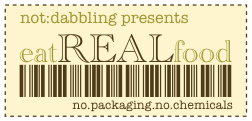Here’s an 8-step by step guide to getting back control of your own food supply, from the simplest to the most obsessed.
Easiest: Stop shopping at the big chains like Safeway
Buy your groceries from the locally-owned neighborhood grocery store, if you’ve still got one. In big cities, you’ll find these in every Polish, Chinese, and Mexican neighborhood, less and less in the other immigrant areas. Don’t be intimidated by the language or the comparative messiness of these stores. They have to abide by the same health laws as the chains. But you’ll be putting money in the pocket of a local, family merchant, rather than a multinational several states away.
A little more challenging. Seek local brands.
You may need a couple of trips to the market, to write down brands so you can research them (or check them out on your smart phone if you’ve got one). A lot of packaging now will say “product of STATE” and/or product of COUNTRY. Careful though. They play games like shipping California milk to Wisconsin and bottling it there, then calling it Wisconsin milk. Diary labels have a code that allow you to track not just where they were bottled, but which farm the product came from.
Still with me? Read some labels.
Buy certified organic. Many shops now carry organic brands, especially the chains, if you don’t have a local family grocer. Check ingredients, too. If it’s got high fructose corn syrup in it, don’t buy it. Let’s get rid of our dependence on King Corn. Even refined sugar is better for you and better for the planet, plus, it tastes better. Yes, this means you'll have to stop buying soda. Don't worry, I've been working on a homemade syrup that tastes like Coke! As soon as I figure it out, I'll share it with you! (So far, some combination of raspberry, coffee, and caramel seems most promising...puts on mad scientist coat and goes back to work.)
A little harder, because now you’re denying yourself stuff
Only buy in season. This means no fresh fruit in the dark of winter in my area. But I’ll let you buy locally-grown preserved fruit and vegetables, including jams, canned, frozen, pickled, etc. You’ll also have to relearn what’s in-season when. You can’t tell anymore by what’s on the shelves.
Do you have some time left?
Don’t buy things with ingredients (this is straight out of Michael Pollan). And I don’t just mean frozen pizzas and pre-prepared meals, or soup in a can. I mean jam, salsa, bread, crackers, granola and other breakfast cereals, desserts, etc. Make them yourself. Soup is easy and cheap. Making jam is rolling off a log. Ditto tomato sauce and paste. Don’t know what you’re doing? I seldom baked before I started trying to eat like this. I thought it was hard. I thought it was boring. Turns out it took exactly 3 weeks to figure out how to make all those baked goods. Even your mistakes will taste better than the corn-syrup and salt-laden imitations they’re forcing down our gullets.
Now it gets challenging. Plan ahead.
I don’t mean plan what you’re going to eat on Friday. I mean plan in July for what you’re going to eat in February. If you want locally grown, organic jams, pies, tomato sauce, and vegetables when snow is on the ground, buy it at the farmer’s market in the summer, and “put it up.” This will be a lot of work in July and August, but basically you won’t have to cook in January, February and March, because you’ll have done it already.
In pretty deep? Plant a vegetable garden.
Start with the things you know you eat a lot. Produce only what you need for the summer at first, then start adding within the constraints of your time and space. If you don't have a yard, put some pots on your porch. If you don't have a porch, put some herbs on a sunny windowsill. Don’t worry about budget. You’ve saved so much money taking the steps above that you have plenty to start a garden. What you can’t grow, buy at the farmer’s market.
Meat, dry goods, dairy
Look on line a FamilyFarmed.com or localharvest.com for merchants, farmers, and markets near you that have these things that are difficult to find locally.
Finally, give yourself a break.
We live in an interconnected, global society. I firmly believe you should eat in season (including imported fruits like oranges), and make things that make sense to make (bread, jam, main dishes) but that you can carry it too far. Humans have always traded. Get your cinnamon from the east, and coffee, and chocolate. Don’t deny yourself oranges in Canada, or rice in Illinois. But seek out fair trade brands, and locally-owned distributors. If you want to eat out or order in, try to find a restaurant that buys locally-grown foods, but the next best thing is to just go to a one-off, family owned business instead of the national chain. For the goddess' sake stay out of MacDonald's, can you do that for me?
If we all follow these steps as far as our time, energy, and budget allow, even if we never get past step one, we'll go a long way toward repairing the damage that our profligate and blindered life style has gotten the planet into.
1 week ago









It's possible to get local stuff at bigger grocery stores, too. One chain makes its own breads and most around here carry local dairy products. Also, not being a big meat eater, I do buy national soy protein type products because local peeps don't make 'em. The thing I find most difficult about shopping for more local foods is not only the price (which I understand but which still doesn't mesh with my reality) but the fact that instead of doing my weekly grocery shopping (which I *hate* by the way) in ONE store, with exceptions on a monthly, bimonthly, or quarterly basis only, I now have to go to two or three stores to get what I need each week. Arg! That actually wastes some of the gas I'm trying to save by buying more locally. Plus, in case you hadn't noticed, it really irritates me.
ReplyDeleteThanks for these great suggestions. I tend to succumb to marketing and convenience in the winter, but am looking forward to the fresh food from the garden very soon now.
ReplyDeleteBut I wanted to comment on your homemade Coke experiment. I recently read an article in the New Yorker on the flavor/fragrance company Givaudan. The article mentioned that Coke is basically citrus-flavored but the color plays tricks with your taste perception. I'll look up the exact quote next week when I have the magazine at hand.
Monica, exactly. See my post on the cost of the time. (one or two back). I was thinking about the fact that you big chains do have bakeries, and some now even have "local food" sections. But you're still putting the profits into the heads of a big corporation, which has no interest in the local community (even if they're headquartered there).
ReplyDeleteAh, Entangled, there you are! Took a while to show up. Thanks for the coke tip. I'll try adding citrus to my on-going quest. I confess, I tried the coffee for the color!
ReplyDeleteA great post! really always something to work on :))
ReplyDeleteby the way, "Mahlzeit" is a German greeting (also Austrian, of course) that you use mainly in the business field during noontime (for example, if somebody leaves the office to have lunch, or when he meets colleagues on the way, he might say "Mahlzeit"). The translation for "bon appetit", the expression that families in Austria and Germany use before starting a meal is "Guten Appetit", wishing everybody a "good appetite" and a pleasant meal!
Hi Sylvia! Welcome to Mahlzeit. I've had other German-speakers also comment on that usage of the term. Even when used thus it comes originally from a blessing or prayer used prior to a meal (grace, as it were). However, in Austria, where I went to college, it is commonly used the way I described. There, the colloquial greeting in a more formal setting is "Grüssen Sie Gott" or "Grüss' Sie" and among friends "Grüs di(ch)" or "Servus." While I can't say no one ever does it, I never heard anyone in Austria use "Mahlzeit" as a generalized greeting.
ReplyDeleteI've done a little research. One of the larger chains around here, Meijer, is headquartered in Grand Rapids. Granted, that's 2 hours away, but profits at least stay in MI. Kroger is another grocery chain. It's headquartered in Cincinnati, but I discovered its dairy products (yogurt, cottage cheese) are from a dairy under 20 miles from me in Ann Arbor. While it may not be organic (I only buy really local milk)... the local local dairies don't make cottage cheese or yogurt and at least it's not being trucked very far. As a self-unemployed single person, cost remains a major consideration... sometimes trumping principle.
ReplyDeleteMonica, I consider both monetary cost and time to be legitimate reasons to modify all-out assault on chain-store shopping. Checking the labels is a great way to find out where your money is being spent, and local chains fit my criteria for local. Unfortunately, our formerly-local Chicago chains are now both owned by "furriners" (i.e. Californians). You can have a huge impact on the local economy and ecology by taking baby steps, too.
ReplyDeleteHi Xan, I now have the New Yorker article (Nov 23, 2009, p. 91) in hand and this is the whole quote on Coca-Cola.
ReplyDelete"Coca-Cola, for instance, is primarily a citrus beverage, its flavor derived from lemon, orange, and lime oils, combined with vanilla, cinnamon, other spices, and corn syrup. Its flavor has little in common with the astringent-tasting kola nut, from which it takes its name, and its caramel coloring is largely imposed."
Also (I had totally forgotten about this because I don't drink soda pop), Coke from Mexico is made with cane sugar. My relatives who drink Coca-Cola proclaimed the Mexican product superior when they tried it.
Still, I'd be really interested in hearing the results of your experiments.
Reading Monica's comment reminded me of another magazine article I recently read, and this one is available online. It seems that Walmart has a serious program to become a purveyor of local food. I could hardly believe it, and I can't say I've checked it out either, but the whole surprising article is here at the Atlantic Monthly website.
ReplyDelete